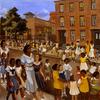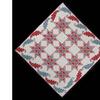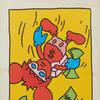Felrath Hines Representation Announcement
- August 12, 2019 15:03
Spanierman Modern is pleased to announce the gallery is now representing the estate of Ferath Hines.
Felrath Hines was an African American painter who wanted his work to speak for itself, and rejected its classification based on his race. He created universal visual idioms from a place of complex personal experience. Over the course of his career, his early figurative and cubist-style morphed into soft-edged, organic abstract work as he experimented with hues in his chosen oil medium, leading to hard-edge geometric abstraction in his later years.
Racial discrimination of the 1960s and 70s and the Civil Rights movement extended to the New York art scene, marginalizing African American artists from exhibition opportunities at many museums and galleries. This resulted in the creation of artistic and social collectives in order to create spaces for congregation. Hines was invited by fellow artist Romare Bearden to co-found the art group Spiral, a space for African American visual artists to convene and dialogue in response to the civil rights movement. Initially they organized transportation logistics to protests such as the March on Washington in 1963, eventually addressing more intellectual concerns, including what author Ralph Ellison called a “new visual order. Unconvinced that any artistic style or subject could or should be categorized exclusively as “black art,” Hines pursued his abstract sensibilities. Despite that the group was only active for a short period of time, it left a strong impact as a historical organization, being one of the first artist groups to be implicated in social change. Hines would remain an activist, and his social life, which included outings at jazz clubs and art openings, led him to meet Frank Neal. Neal would host luminaries such as James Baldwin, Harry Belafonte, Charles Sebree and Billy Strayhorn at his apartment to discuss creative and social issues, as well as their careers and place in a white-dominant world.
Hines made his living as a conservationist and became known for his impeccable work and accurate and sensitive in-painting, leading him to open a private conservation practice in 1964. His client list counted the Museum of Modern Art, the Whitney Museum, the Corcoran Gallery of Art and Georgia O’Keeffe, who would become a loyal friend. In 1972 he was the first African American to become Chief Conservator of the Smithsonian Institution’s National Portrait Gallery then that of the Hirshhorn Museum and Sculpture Garden, a position from which he retired in 1984. From that time to his death in 1993, he produced more paintings than during the rest of his career combined.
Hines struggled with the idea that there was an expectation for him to create “black art,” which should be primarily relevant to the African American community. He was an activist, dedicated to social equity and justice, yet his artwork was apolitical and universal – the abstract style he worked in was considered mainstream, nevertheless he was still overlooked during his lifetime.
For any additional information on the artist and his work, please contact the gallery by email at info@spaniermanmodern.com or by phone at 786-542-5656.
















100x100_c.jpg)

